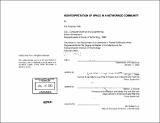Reinterpretation of space in a networked community
Author(s)
Park, Kat Suejung, 1973-
DownloadFull printable version (14.29Mb)
Other Contributors
Massachusetts Institute of Technology. Dept. of Architecture.
Advisor
William Porter and William J. Mitchell.
Terms of use
Metadata
Show full item recordAbstract
One of the most significant reasons why architects dwell on the design of a space is because we believe that the physical environment will influence social and interpersonal relationships. Recognizing the limitations in the conventional design paradigms, this project brings the focus on the inhabitants' interactive behavior and communication patterns as the main parameter influencing the design of an academic environment. In contemporary academic infrastructure, computer-mediated communication has become an integral method of communication, providing a new platform for exchange of ideas and information. Despite this change, spatial organization and other architectural elements that govern the interactions remain traditional, disconnecting inhabitants from their interaction protocols. The first section of this thesis expands on the current role played by compute-mediated communication in a networked community. Extending beyond simple exchanges of email or instant messages, the design exercise produces a collaborative online platform which translates the physical community and its existing human interactions into the digital realm, as well as extend the existing spaces and social infrastructure. The influence of the redefined and redistributed spaces on the individuals' identity, perception, and their relationship to the organizational culture becomes the new design variable that initiates an investigation into different notions of space and physical architecture. By illustrating scenarios of user interaction and behavior, this thesis proposes a new model for integration of technology into the physical architecture that can clarify and foster new interactions and new ways to share knowledge and experience in an academic environment.
Description
Thesis (M.Arch.)--Massachusetts Institute of Technology, Dept. of Architecture, 2003. Includes bibliographical references (leaves 57-58).
Date issued
2003Department
Massachusetts Institute of Technology. Department of ArchitecturePublisher
Massachusetts Institute of Technology
Keywords
Architecture.